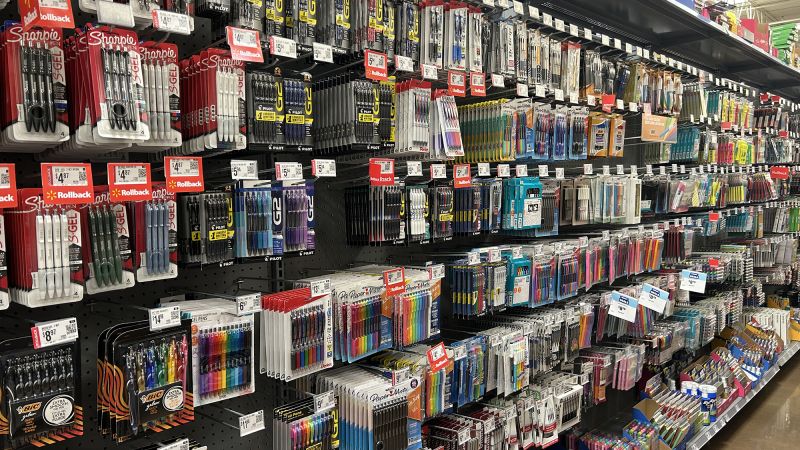As the summer winds down and children prepare to return to classes, back-to-school shopping has officially commenced, with many families racing to secure essentials for the upcoming academic year. This year’s shopping season is marked not only by the typical rush for supplies but also by the looming specter of tariffs affecting pricing for a wide array of goods.
According to a recent survey conducted by the National Retail Federation (NRF), approximately two-thirds of American households with school-aged children initiated their shopping efforts considerably earlier than in previous years—beginning in July, the earliest recorded start to these shopping endeavors. Many families are motivated by concerns that the current tariffs instituted under the Trump administration could exacerbate price inflation, causing them to seek out bargains and reassess their spending habits.
Katherine Cullen, who serves as the vice president of industry and consumer insights at NRF, articulated how consumer behavior has shifted this year. She noted that shoppers are increasingly mindful of the potential financial impacts that tariffs and inflation could have on back-to-school items. As a result, many are turning to early shopping ventures, utilizing discount stores, and capitalizing on summer sales to secure savings on essential supplies.
The NRF’s survey revealed a notable trend: half of back-to-school shoppers cited their worries about potential price hikes due to tariffs as a primary reason for their early shopping this year. Many of the essential items, including backpacks, clothing, and electronics, are sourced from international markets, where fluctuation in tariffs can readily influence prices on the retail level.
The urgency surrounding this shopping season is heightened by impending tariff increases, particularly scheduled for August 1. As it stands, these tariffs would escalate on most international trading partners of the United States unless a trade agreement is reached prior to that date. Trump recently announced a new trade deal with Japan, imposing a 15% tariff on Japanese imports, while China is currently facing a hefty 30% tariff set to remain in place until August 12.
Retail analysts, like Adam Davis from Wells Fargo retail finance, offer additional insights into the anticipatory purchasing pattern observed this year. Davis noted that shoppers are motivated by attractive promotional deals frequently offered by retailers in July, alongside a tangible desire to sidestep looming price increases and potential inventory shortages triggered by tariff-related uncertainties.
While more American families are beginning their back-to-school shopping earlier and with a heightened sense of urgency, they are also exercising greater caution regarding their overall spending. NRF forecasts that families will spend roughly $858 on clothing, supplies, and electronics this year, reflecting a modest 2% decline compared to the previous year. This shift suggests that consumers are prioritizing value and necessity over extravagance, prompting a trend of downgrading from brand-name products to more affordable private-label alternatives.
In this fiercely competitive shopping climate, retailers are actively vying for consumer dollars. Major players like Target are hosting back-to-school events with claims of discounts reaching as high as 30%, alongside commitments not to raise prices on popular school supplies. Similarly, Walmart has reported that 14 of its most sought-after school supplies are cheaper than they were last year, reinforcing the message that a frugal approach to back-to-school shopping is prevalent among consumers. In fact, a staggering 70% of Walmart shoppers indicated in company surveys that they plan to dedicate more time to seeking out discounts this season.
Retail experts observe this dynamic between retailers and consumers with keen interest. As Davis remarked, there is an evident rise in efforts by retailers to maximize sales during summer months, directly tying discounts to school necessities in order to engage budget-conscious shoppers.
Moreover, beyond the conventional retail front, Amazon successfully capitalized on consumer interests during its recent four-day Prime event, which resulted in record sales amounting to $24.1 billion—up 30% from the prior year. Sales of back-to-school supplies surged impressively by 175%, demonstrating the power of competitive pricing in attracting consumers seeking affordable options.
Nevertheless, analysts, including John Zoldis of Quo Vadis Capital, caution that the temporary price advantages consumers are currently enjoying may soon dissipate. As retailers begin to run through their existing inventory—sourced prior to the enactment of tariffs—shoppers are likely to face increased prices in the coming weeks, potentially experiencing the ramifications of tariffs in about two to four weeks’ time.
In summary, the back-to-school shopping landscape this year reflects a convergence of early purchasing trends, careful budgeting, and impending tariff consequences, leading consumers to navigate the season with both urgency and caution.












